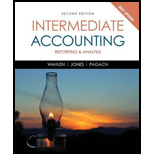
Prepare a corrected comparative income statement for the years 2017 and 2016 of Company T.
Explanation of Solution
Horizontal analysis of financial statements: In horizontal analysis of financial statement, the amount of each item of the current period’s financial statement is compared with the previous period’s financial statement. The amount of each item increased or decreased in the current financial statement, and its respective percentage can be computed by taking the previous period statement as the base. This analysis is also known as trend analysis. The horizontal analysis percentage is calculated by using the given formula:
Prepare a corrected comparative income statement for the years 2017 and 2016 of Company T.
| Company T | ||
| Comparative Income Statement | ||
| For the Year Ended December 31 | ||
| Particulars | 2017 | 2016 |
| Amount ($) | Amount ($) | |
| Sales | (1) $2,900,000 | (2) $3,900,000 |
| Cost of goods sold | (3) ($980,000) | (4) ($2,310,000) |
| Gross profit | $1,920,000 | $1,590,000 |
| Operating expenses | (5) ($1,020,000) | (6) ($1,390,000) |
| Operating income | $900,000 | $200,000 |
| Other item: | ||
| Loss from obsolescence inventory | ($150,000) | $0 |
| Unusual loss | $0 | ($60,000) |
| Unusual gain | $250,000 | |
| Miscellaneous | (7) ($50,000) | (8) ($90,000) |
| Pretax income from continuing operation | $700,000 | $300,000 |
| Less: Income tax expense | ($210,000) | ($90,000) |
| Result from discontinuing operations: | ||
| Income (loss) from operations of discontinued division | (9) ($210,000) | (10) $210,000 |
| Loss on write-down of held-for-sale backscratcher | (11) ($112,000) | $0 |
| Net income | $168,000 | $420,000 |
Table (1)
Working note (1):
Calculate the amount of sales for 2017:
Working note (2):
Calculate the amount of sales for 2016:
Working note (3):
Calculate the amount of cost of goods sold for 2017:
Working note (4):
Calculate the amount of cost of goods sold for 2016:
Working note (5):
Calculate the amount of operating expenses for 2017:
Working note (6):
Calculate the amount of operating expenses for 2016:
Working note (7):
Calculate the amount of miscellaneous expenses for 2017:
Working note (8):
Calculate the amount of miscellaneous expenses for 2016:
Working note (9):
Calculate income/loss from operations of discontinued division for 2017:
Working note (10):
Calculate income/loss from operations of discontinued division for 2016:
Working note (11):
Calculate loss on write-down of held-for-sale backscratcher:
Want to see more full solutions like this?
Chapter 5 Solutions
Intermediate Accounting: Reporting and Analysis, 2017 Update
- Dylan Manufacturing had an estimated 90,000 direct labor hours, $360,000 manufacturing overhead, and 30,000 machine hours. The actual results were 91,200 direct labor hours, 32,500 machine hours, and $415,000 manufacturing overhead. Overhead is applied based on machine hours. Calculate the predetermined overhead rate. Need helparrow_forwardRivertown Media has reported a total asset turnover of 2.8 times and an ROA of 15% and ROE of 22%. What is the firm's net profit margin?arrow_forwardWhat is the return on equity ?arrow_forward
- Cypress Ltd.'s contribution margin is $250, after-tax income is $90, and the tax rate is 25%. What are the fixed costs? a. $65 b. $175 c. $130 d. None of the above HELParrow_forwardGeneral accounting question with helparrow_forwardDylan Manufacturing had an estimated 90,000 direct labor hours, $360,000 manufacturing overhead, and 30,000 machine hours. The actual results were 91,200 direct labor hours, 32,500 machine hours, and $415,000 manufacturing overhead. Overhead is applied based on machine hours. Calculate the predetermined overhead rate. Helparrow_forward
 Financial Accounting: The Impact on Decision Make...AccountingISBN:9781305654174Author:Gary A. Porter, Curtis L. NortonPublisher:Cengage Learning
Financial Accounting: The Impact on Decision Make...AccountingISBN:9781305654174Author:Gary A. Porter, Curtis L. NortonPublisher:Cengage Learning Intermediate Accounting: Reporting And AnalysisAccountingISBN:9781337788281Author:James M. Wahlen, Jefferson P. Jones, Donald PagachPublisher:Cengage Learning
Intermediate Accounting: Reporting And AnalysisAccountingISBN:9781337788281Author:James M. Wahlen, Jefferson P. Jones, Donald PagachPublisher:Cengage Learning

